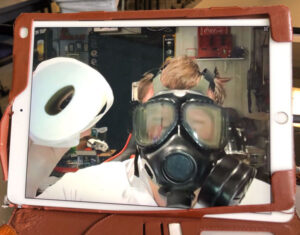By Jordan Beach
Amid the COVID-19 pandemic, life continues to change on a daily basis. Whether directly affected by the virus or altering how businesses function, the world continues to experience these changes as we work toward the common goal to slow the virus’ spread, and higher education is no different.

A student from Elizabeth Smith’s class dressed in a gas mask to attend an online course video chat.
Higher education experienced a total shift to distance learning, not to mention the loss that came with canceled and postponed events, from performances to sporting events, college traditions to long-awaited commencement ceremonies.
Reinhardt University offers students an intimate experience in the classroom, where creating a bond with faculty members during office hours is commonplace, fostering connections that last a lifetime.
Online learning would appear to eliminate the typical face-to-face interactions many students thrive on at a small-scale university. Reinhardt University is particularly unique in this aspect with its low student-to-faculty ratios. However, with a spirit amongst faculty, staff and students that tends to persist in the strongest winds of change, Reinhardt continues its efforts to connect with students through education on a personal level.
Reinhardt’s faculty, some of which never taught an online course, moved their courses entirely online for the remainder of the semester. Assistant Professor of Physics Dr. David Moore is one faculty member forced to learn a great deal in a short amount of time. In his experience, his students aided in shifting the classroom dynamics.
“Students are resilient and amazing,” said Moore. “They adjusted to the transition very well and helped me through as well.”
Several ways Moore continues to engage his students includes publishing audio slideshows of his lecture notes, using screen capture video to capture handwritten problems and solutions and using the quiz function on Canvas to check and reinforce lectures.
Elizabeth Smith, assistant professor of math, is also new to teaching online. She feels her students are coping well yet she misses her favorite part of teaching: the energy, excitement and enthusiasm her students bring to the classroom. Moments like Smith’s student logging into their virtual, video chat-style class in a gas mask holding toilet paper make the transition feel less daunting all around.
“I think the students have done an amazing job,” said Smith. “In speaking with other teachers, they all agree that students are remarkably patient and agreeable and hardworking.”
Students altered their learning experience to a remote one, with some never having enrolled in a completely online course. Graphic design major and music minor Ariana Azahar ’22 felt some of her professors were initially slow to respond to the transition, but now appear to all be on the same page and moving forward together.
“I have never taken online classes before,” said Azahar. “It has been hard for me as I do best doing things in person with my professors, but since we started using Canvas more this year, it hasn’t been too difficult for most of my classes transitioning.”
Some classes, such as astronomy and music, were more difficult to transition online. Azahar appreciates the efforts professors like Moore are making to help students get the most out of the remainder of the semester.
“I feel that Dr. Moore has tried his best to engage with his students despite that we are now so far apart. He is always willing to answer our questions that we send him over email and helps us understand what we can’t online. He is also willing to take the feedback we give him about any issues with our online assignments and will accommodate for anything that is missing or not working.”
Moore also offers extra credit to students who submit selfies with their families and pets. His astronomy courses, known for early morning star gazing sessions on campus, receive extra credit by hosting their own virtual star gazing “parties” when they take pictures with stars in the background.
Despite faculty and students making strong efforts on both fronts, some aspects of hands-on education will never quite compare when virtual.
“Normally, my office hours are great. Four to five students come in at a time and work out problems on the board and I barely help them except to give a little hint now and then,” Smith said. “They 100 percent help each other. I wish we could still do that because it’s the best way to learn and practice difficult math.”
While distance learning presents a number of challenges, with patience and adaptation, Reinhardt has developed creative solutions to make the most of the shift in learning brought on by the global pandemic.

